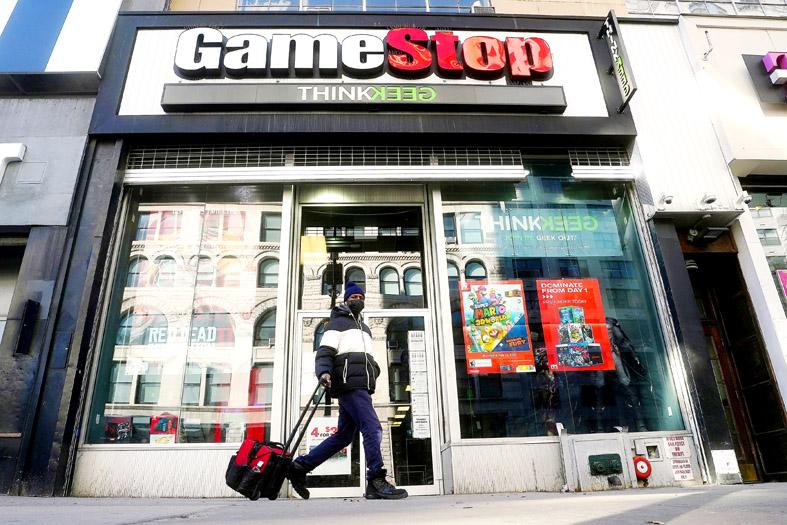The battle between retail investors and hedge funds burst seemingly out of nowhere last week, and many people have spent the weekend wondering how it would end.
The answer depends in part on two things: First, who will be first among the three group of actors — hedge funds shorting the handful of stocks, retail investors buying them and the intermediaries enabling both sides to trade — to surrender, especially if done through a disorderly unwinding of their book? Second, how will regulators and politicians react?
What has been colorfully, and not that inaccurately, labeled as the uprising of the little guys reflects the confluence of information platforms, data, and easy-to-use products and trading apps — all of which have been helping the more general phenomenon of democratizing finance.

Photo: Reuters
In addition to technology, big data and some relatively simple forms of artificial intelligence, the fuel also involved an accumulation of years of the everyday small investor feeling marginalized and disadvantaged by a finance establishment that appeared to have co-opted the US Federal Reserve and other agencies.
The catalyst — helped by the availability of cash and, in some cases, stimulus checks — came in the form of the discovery of a strategy in which the usual power brokers, led by the so-called smart money (the term historically used to refer to hedge funds), were significantly vulnerable. This strategy involved an ad hoc movement to buy the stocks of the most heavily shorted companies in the hope of triggering a short squeeze and forcing the bears to scramble and cover their positions.
It is a strategy that worked especially well in the case of GameStop Corp, where the accumulated shorts were equivalent to about 140 percent of the outstanding stock.
The hedge funds shorting were not the only ones exposed to what in markets is known as a pain trade. The intermediaries also found themselves under growing pressure, scrambling to safeguard their balance sheets and maintain prudential guidelines, being forced to cough up cash, draw on credit lines or both.
By the end of the week, all three actors were still in the game. Who will be knocked out first is far from straightforward.
Historically, small investors pushing up a handful of stocks would be at most risk of being picked off because of their limited individual capital, especially when squaring off against professional hedge funds. Under that outcome, the implications for the financial system would be relatively small notwithstanding the losses incurred by these investors.
Similar to a phenomenon that first came to global attention during the Arab Spring in the early 2010s, social media, and in this specific case Reddit, has enabled usually dispersed investors to become more of a strong collective force with a common purpose. To confront this new force and stay in the game, hedge funds have already been driven to raise cash to meet higher margin calls, with some also stopped out of their short positions.
This compelled a few of them to sell some of their long holdings, with the inclination to dispose of their most liquid ones. With that comes an element of market-wide contagion, the extent of which will depend on the strength of what, at least until now, has been a remarkable countervailing “buy the dip” conditioning.
Such damage to general asset prices, producing the worst week for the S&P 500 Index since October last year, pales in comparison to what would most likely happen if one of the intermediaries were forced into a disorderly deleveraging, whether it be a broker or central clearinghouse. If not handled well, this could have much broader effects, especially because the nonbank segment of the financial system has been in an unprecedented period of rapidly rising debt, leverage and risk-taking, aided and abetted by too many years of excessive policy reliance on experimental central bank measures, and regulatory and supervisory gaps.
Regardless of which of these scenarios plays out — and, to make things, even more interesting, they are not mutually exclusive — regulators and politicians can be expected to become involved in some capacity.
Harder to predict is what particular element they will focus on most; some can have competing effects on asset prices and market functioning. Among the targets could be small investor protection, investment suitability criteria, margin limits, possible collusion and price manipulation, and market structure.
What started out as a market curiosity — small investors taking on the Wall Street establishment using what had been periphery platforms too easily dismissed by the traditional market powers — has both broader origins and implications.
This is not just an epic David versus Goliath story that has attracted worldwide media attention. Potentially in play is the democratization of finance, tech-led disruptions to market hierarchy, the overall valuation of markets, regulatory and political responses, and the market structure itself.
Mohamed El-Erian is a Bloomberg Opinion columnist and president of Queens’ College, Cambridge; chief economic adviser at Allianz SE, the parent company of Pacific Investment Management Co, where he served as CEO and co-chief investment officer; and chair of Gramercy Fund Management.
This column does not necessarily reflect the opinion of the editorial board or Bloomberg LP and its owners.

The demise of the coal industry left the US’ Appalachian region in tatters, with lost jobs, spoiled water and countless kilometers of abandoned underground mines. Now entrepreneurs are eyeing the rural region with ambitious visions to rebuild its economy by converting old mines into solar power systems and data centers that could help fuel the increasing power demands of the artificial intelligence (AI) boom. One such project is underway by a non-profit team calling itself Energy DELTA (Discovery, Education, Learning and Technology Accelerator) Lab, which is looking to develop energy sources on about 26,305 hectares of old coal land in

Taiwan’s exports soared 56 percent year-on-year to an all-time high of US$64.05 billion last month, propelled by surging global demand for artificial intelligence (AI), high-performance computing and cloud service infrastructure, the Ministry of Finance said yesterday. Department of Statistics Director-General Beatrice Tsai (蔡美娜) called the figure an unexpected upside surprise, citing a wave of technology orders from overseas customers alongside the usual year-end shopping season for technology products. Growth is likely to remain strong this month, she said, projecting a 40 percent to 45 percent expansion on an annual basis. The outperformance could prompt the Directorate-General of Budget, Accounting and

Netflix on Friday faced fierce criticism over its blockbuster deal to acquire Warner Bros Discovery. The streaming giant is already viewed as a pariah in some Hollywood circles, largely due to its reluctance to release content in theaters and its disruption of traditional industry practices. As Netflix emerged as the likely winning bidder for Warner Bros — the studio behind Casablanca, the Harry Potter movies and Friends — Hollywood’s elite launched an aggressive campaign against the acquisition. Titanic director James Cameron called the buyout a “disaster,” while a group of prominent producers are lobbying US Congress to oppose the deal,

Two Chinese chipmakers are attracting strong retail investor demand, buoyed by industry peer Moore Threads Technology Co’s (摩爾線程) stellar debut. The retail portion of MetaX Integrated Circuits (Shanghai) Co’s (上海沐曦) upcoming initial public offering (IPO) was 2,986 times oversubscribed on Friday, according to a filing. Meanwhile, Beijing Onmicro Electronics Co (北京昂瑞微), which makes radio frequency chips, was 2,899 times oversubscribed on Friday, its filing showed. The bids coincided with Moore Threads’ trading debut, which surged 425 percent on Friday after raising 8 billion yuan (US$1.13 billion) on bets that the company could emerge as a viable local competitor to Nvidia